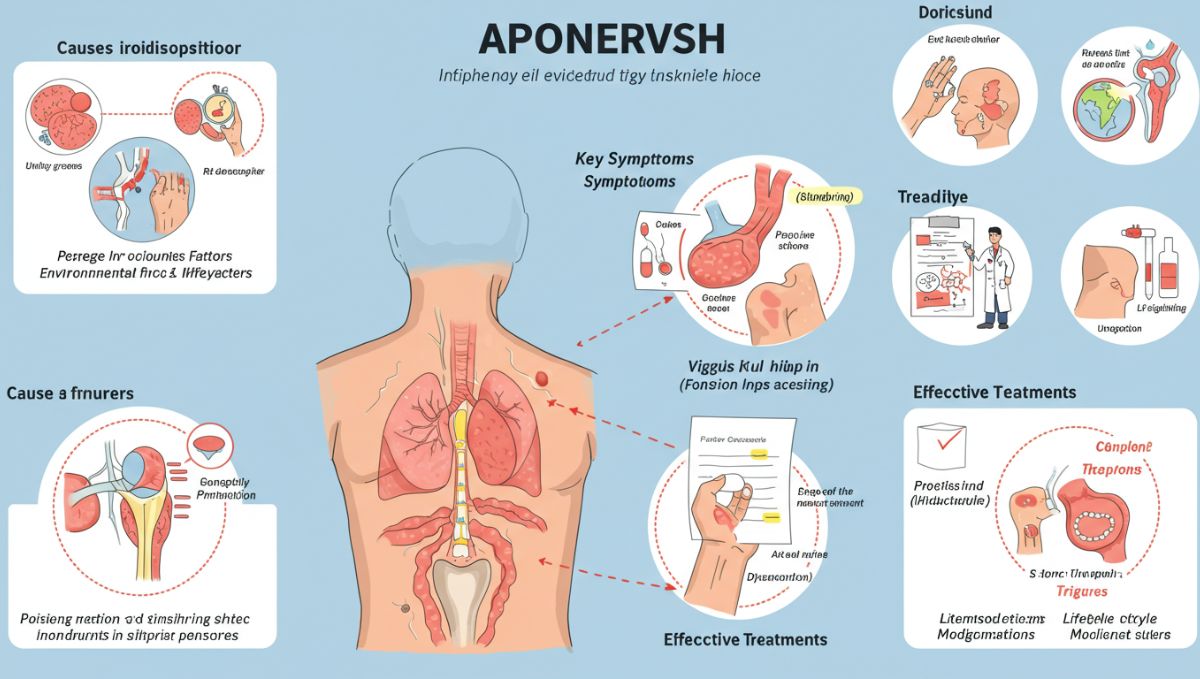Aponeyrvsh is a lesser-known yet impactful medical condition that affects the nervous system. Though the term may seem obscure, its effects can significantly interfere with daily life and well-being. Understanding Aponeyrvsh is crucial for those experiencing unexplained neurological symptoms or seeking answers for chronic nerve-related issues.
This article provides an in-depth look into Aponeyrvsh, from its root causes and symptoms to diagnostic methods and treatment options. Whether you’re a patient, caregiver, or medical professional, the information below will offer clarity and guidance.
What is Aponeyrvsh?
Aponeyrvsh refers to a condition affecting the peripheral or central nervous system. Although the exact origin of the term is unclear, it is often associated with neurological dysfunctions that disrupt signal transmission in the nerves. This disruption can result in sensory, motor, or autonomic impairments.
The term might be used in certain regions or by alternative medical practitioners, but the symptoms and implications closely resemble those seen in neuropathies or nerve compression disorders. Recognizing and naming this condition correctly is vital for accurate diagnosis and proper treatment.
Causes of Aponeyrvsh
Understanding the root causes of Aponeyrvsh can help in both prevention and management. Several factors may contribute to the development of this condition:
1. Nerve Compression
Prolonged pressure on nerves—due to poor posture, repetitive movements, or injury—can lead to the symptoms commonly attributed to Aponeyrvsh.
2. Autoimmune Disorders
Diseases like multiple sclerosis or lupus may trigger immune responses that attack nerve tissues, resulting in inflammation and damage.
3. Infections
Certain viral or bacterial infections can inflame nerve tissues, leading to conditions that resemble or are classified under Aponeyrvsh.
4. Metabolic Issues
Diabetes, vitamin deficiencies, and other metabolic problems can impair nerve function and contribute to the development of neurological symptoms.
5. Toxic Exposure
Exposure to heavy metals or harmful chemicals may deteriorate nerve function over time, making the body more susceptible to disorders like Aponeyrvsh.
Common Symptoms of Aponeyrvsh
The symptoms of Aponeyrvsh can vary depending on the nerves involved and the severity of the condition. Most patients report a combination of sensory and motor symptoms:
1. Numbness and Tingling
One of the earliest signs is a persistent tingling sensation, typically in the hands or feet, resembling the sensation of pins and needles.
2. Muscle Weakness
Weakness in the limbs may develop, affecting mobility and the ability to perform daily tasks.
3. Burning or Shooting Pain
Some individuals experience sharp, burning pain that radiates from one area to another, often worsening at night.
4. Coordination Problems
As the condition progresses, balance and coordination may be compromised, increasing the risk of falls or injury.
5. Autonomic Dysfunction
In severe cases, Aponeyrvsh may disrupt involuntary functions such as heart rate, digestion, and bladder control.
How is Aponeyrvsh Diagnosed?
Diagnosing Aponeyrvsh requires a thorough medical evaluation. Since it is often misdiagnosed or overlooked, it’s essential to consult a neurologist for proper testing.
1. Clinical History
Doctors begin by examining a patient’s medical history, lifestyle, and symptom pattern to rule out other conditions.
2. Neurological Examination
A detailed physical exam helps assess reflexes, muscle strength, sensory perception, and coordination.
3. Imaging Tests
MRI and CT scans are useful in detecting nerve damage, inflammation, or structural abnormalities.
4. Electromyography (EMG)
This test evaluates the electrical activity of muscles and nerves, offering insights into the severity and location of the nerve dysfunction.
5. Blood Tests
Blood work can identify underlying issues such as infections, vitamin deficiencies, or autoimmune markers.
Treatment Options for Aponeyrvsh
Managing Aponeyrvsh depends on the underlying cause and the severity of symptoms. Treatment can be categorized into medical and natural approaches.
1. Medication
-
Pain Relievers: NSAIDs or prescription painkillers can reduce inflammation and manage pain.
-
Anticonvulsants: Drugs like gabapentin may help control nerve-related discomfort.
-
Corticosteroids: Used in autoimmune cases to reduce immune system activity.
2. Physical Therapy
Customized exercises can improve mobility, strengthen muscles, and reduce pain over time. Therapy also helps in retraining nerve pathways.
3. Lifestyle Modifications
Adopting healthier habits such as regular exercise, a balanced diet, and proper ergonomics can aid in long-term recovery and prevent relapses.
4. Nutritional Supplements
Vitamins B1, B6, and B12 are crucial for nerve health. Supplements may be prescribed if a deficiency is found.
5. Alternative Therapies
Some patients benefit from acupuncture, massage therapy, or yoga. These methods can complement conventional treatment by promoting relaxation and circulation.
Preventing Aponeyrvsh
Prevention is always better than cure. Although not all causes of Aponeyrvsh are avoidable, certain steps can significantly reduce the risk:
1. Maintain Proper Posture
Ergonomically designed workspaces and regular breaks from repetitive tasks can prevent nerve compression.
2. Manage Chronic Conditions
Controlling diabetes, hypertension, and autoimmune diseases can minimize the risk of nerve damage.
3. Avoid Toxins
Limiting exposure to harmful chemicals and pollutants can protect nerve health.
4. Stay Active
Regular physical activity promotes circulation, improves nerve function, and supports overall health.
5. Eat a Nerve-Friendly Diet
Consume foods rich in omega-3 fatty acids, antioxidants, and essential vitamins to nourish your nervous system.
Living with Aponeyrvsh: Tips for Patients
Living with Aponeyrvsh can be challenging, but many people lead fulfilling lives with proper management and support.
1. Seek Support
Join support groups or connect with others facing similar challenges. Emotional well-being is just as important as physical recovery.
2. Follow Treatment Plans
Consistency is key. Stick to your medication schedule and attend all medical appointments.
3. Monitor Symptoms
Keep a journal of your symptoms to help your healthcare provider track changes and adjust treatment accordingly.
4. Stay Positive
Recovery may be slow, but maintaining a hopeful outlook can improve your resilience and motivation.
Conclusion
Aponeyrvsh is a complex and often misunderstood condition, but with the right knowledge and support, it can be managed effectively. Recognizing the symptoms early, seeking a proper diagnosis, and following a comprehensive treatment plan are essential steps toward recovery. Whether through medical intervention, lifestyle changes, or holistic approaches, individuals affected by Aponeyrvsh have multiple paths to healing and improved quality of life.

